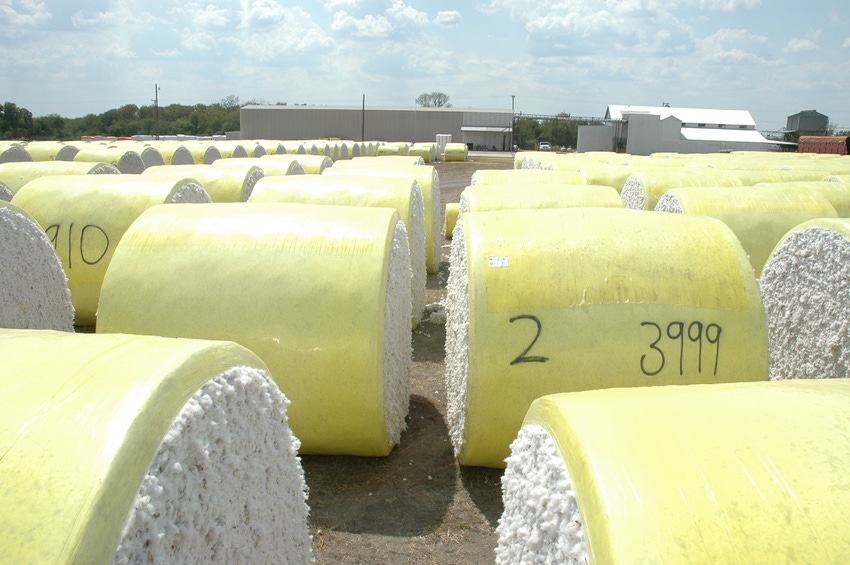
Small, short-lived pricing opportunities may provide the best chance for U.S. cotton farmers to lock in any profit for the 2016 crop.
“You must have a plan,” Kevin Brinkley, president and CEO, Plains Cotton Cooperative Association, told Oklahoma cotton growers at the annual Carnegie Cooperative Cotton Conference at Carnegie, Okla. “This sideways market is likely to continue for the foreseeable future.
“It will be a challenge,” he says, “but producers need to do something other than hold all their cotton until harvest. Consider placing cotton in a pool, or look at other alternatives — but just develop a plan. We’ve sold some of the 2016 crop already.”
Producers with high quality cotton will find an early market, Brinkley says. “Quality cotton will be in demand.” But growers may have difficulty finding out how much high quality fiber is available. “Sellers want to keep that information close to the vest,” he says. “That makes information hard to come by. But call us; we’ll try to help.”
The last 18 months have been challenging for cotton growers. “After the 2010 run-up, prices stayed at an acceptable level for a while, but markets have deteriorated since then,” he says. Those high prices discouraged consumption. “We need to find a balance in the market, an equilibrium in supply and demand, and a price that’s acceptable to the producer and the consumer.”
A FALSE SENSE
The historically high prices in 2010 — as much as $2 a pound — created a false sense that the market was creating a new benchmark for cotton prices, Brinkley says. Unfortunately, that didn’t last.
“Now, we have a lot of cotton we can’t find a home for,” he says. “Cotton dropped below 50 cents a few weeks ago, but it came back a little. No one wants to grow cotton for 54 or 55 cents a pound. Producers can’t cover expenses at that price.”
Cotton markets are dealing with a demand problem, he says. “We lost market share when prices shot up so high. We spent a lot of time and effort getting customers over the last few decades; then, when prices ran up, we lost it quickly.”
For the latest on southwest agriculture, please check out Southwest Farm Press Daily and receive the latest news right to your inbox.
The enemy now is not foreign competition, he says. Rather, “It’s polyester. Manufacturers are looking for inexpensive fiber, and polyester is cheap — 50 cents a pound at the mill. We have to get back to a point where cotton is again the preferred fiber, even if it is more expensive than polyester.”
For fabric to display a 100 percent cotton label is not the current goal, he says. “We want to get back into the game — we want to be part of the mix. We are now fighting the same battle we fought in the 1970s. We want to see fabric containing at least 50 percent cotton, and then work back to a bigger percentage of cotton.”
The long term goal, he says, will be to see a lot of 100 percent cotton labels. But that’s not the immediate concern.
The industry has to find a way to compete with polyester, which offers the advantages of price and ease of use, Brinkley says. “It hurts to see the impact today’s market has on farmers.”
CHINA: A DARK CLOUD
China remains the dark cloud hovering over the industry, he says. “They will sell their huge cotton surplus; it just will take some time.”
China’s one-child policy has created a population crisis, he says. “Their population is aging and not being replaced. China is now the No. 1 investor in robotic technology.”
China’s population also is moving. “Agricultural production is out west; the population is increasingly in the eastern one-third of the country, as people move to urban areas looking for jobs. The old question, ‘How you gonna keep ‘em down on the farm?,’ is a serious one for the Chinese government.
Thus far, the government has “paid farmers to stay; for example, they pay cotton farmers $1.40 to $1.45 per pound to stay and grow cotton.”
China’s cotton stockpile is aging, Brinkley says. “They paid too much for the cotton, and they haven’t bought any cotton for two years.” Observers expect China to auction some 20 million bales soon. “We’re not sure of the pricing, and we’re not sure of the quality. Some of their cotton goes back to the 2011 crop. Most of the cotton going up for auction will be from 2012.”
U.S. markets could take a hit when those bales are offered for sale, he says. “China needs to get rid of these stocks. If they get rid of all of it quickly, it will be painful. But, it could be a long, drawn-out process,” which would keep a lid on markets until the surplus is exhausted.
Either position will cause frustration in U.S. cotton markets, Brinkley says. That’s why cotton farmers need to stay as informed as possible about supply and demand, maintain good yields of top quality cotton, and develop a marketing plan to take advantage of any upward blips in the sideways market.
About the Author(s)
You May Also Like






